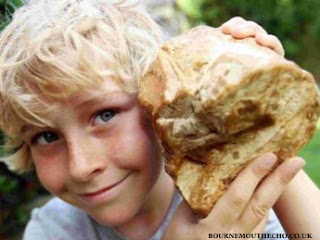The Hunt for Hyper-Condensed Sperm Whale Poop: Christopher Kemp’s Floating Gold
By
Ben Shattuck posted at 12:00 pm on May 24, 2012
Leave it to a molecular biologist to so lyrically detail the scent of hyper-condensed sperm whale poop.
Christopher Kemp, in his first nonfiction book,
Floating Gold: A Natural (& Unnatural) History of Ambergris, writes
It has taken decades to become the substance I am holding
in my hand. In its complex odor is reflected every squall and every
cold gray wave. I am smelling months of tidal movement and equatorial
heat—the unseen molecular degradation of folded compounds slowly
evolving and changing shape beneath its resinous surface. A year of
rain. A decade spent swirling around a distant and sinuous gyre. A dozen
Antarctic circuits.

People have used ambergris (‘gray amber,’ French) for a long time —
Moctezuma added it to his tobacco,
Casanova to his chocolate mousse, England’s
King Charles II
to his eggs; 17th-century French physicians used it to cure rabies,
Florida’s American Indians as an antidote for fish poison, and today,
companies like Chanel and Guerlain as fixative in their most expensive
perfumes.
But exactly what it is or how it’s produced has a long history of
misunderstandings. Before Nantucket whalemen hacked it out of sperm
whales’ intestines in the early 18th century, Europeans were mystified
by the fragrant nubbins randomly washing ashore. To name a few mistaken
sources, among a long list compiled by Kemp, it was at one time or
another thought to be the fruit of underwater trees, extra-terrestrial
rocks, or fossilized tree sap; the Chinese called it “dragon’s spittle.”
Still, we can’t seem to get it exactly right. Just last month
Canadian researchers found that a compound from balsam fir trees can
effectively replace ambergris in perfumes. Following the discovery were a
number misinformed headlines: “Breakthroughs in Science: ‘Whale Barf’
Is No Longer Needed to Make High-End Perfume” (
The Atlantic, 6 April 2012); “Your Perfume may soon be free of Whale Vomit” (
New York Daily News, 9 April 2012).
But as the Tasmanian fisherman
Louis Smith could
have told you — who, Kemp uncovered, in 1891 wormed his way down the
bowels of a beached sperm whale to find a 162-pound hunk of ambergris —
it definitely is not vomit; it definitely comes out the other end.
Kemp, an American working at New Zealand’s Otago University, became
interested in ambergris when a small boulder of tallow washed ashore
and, mistaken for ambergris, was sliced up into assumingly small
fortunes by the local Kiwis. At $20 per gram, that meant the authentic
32-pounder
Lorelee Wright found on an Australian beach in 2006 was worth about $300,000.
After finding disparagingly little literature on ambergris — aside
from a handful of passages in old books — Kemp set out to write
something like the first Concise History of Ambergris,
chapter-to-chapter playing cetologist, maritime historian, and, after he
sets out to find his own piece, lottery junkie.
In his treasure hunt, we follow him from distant, windswept
coastlines (my favorite, the “biscuit-colored apron of sand” notched in
the little wet Stewart Island off the southern coast of South Island,
New Zealand) to dusty storage rooms in the bowels of museums.
Along the way Kemp parses centuries of one of the more fanciful
natural histories, illuminating a not-so-distant past of scientists
flailing around to understand the natural world. Right around the time
the first American paper on ambergris was published (1720s, by
Zabdiel Boylston,
Cotton Mather’s
physician), appeared papers on “The Height of a Human Body, between
Morning and Night,” and “Some Observations Made in an Ostrich, Dissected
by Order of Sir Hans Sloane, Bart.”
It’s hard not to fall in love with ambergris, or the concept of
ambergris as the unknowable embodiment of the sea, along with Kemp. Here
is a solid lump of whale feces, weathered down—oxidized by salt water,
degraded by sunlight, and eroded by waves — from the tarry mass to
something that smells, depending on the piece and whom you’re talking
to, like musk, violets, fresh-hewn wood, tobacco, dirt, Brazil nut,
fern-copse, damp woods, new-mown hay, seaweed in the sun, the wood of
old churches, or pretty much any other sweet-but-earthy scent. Borne in
whale guts to be crushed and dabbed on the wrists and necks of the
elite.

In following Kemp to where spume and salt and storms dash the seaboard — and all the
Moby Dick
references—I can’t help but think of Ishmael, ruminations on sea and
land blowing through the pages. Kemp’s treks along the fringes of
distant islands, his ponderous observations of thunderheads — “enormous
black columns that tower thousands of feet into the sky” — washing over
remote beaches, strike the same chords as
Melville’s
Ishmael in the crow’s nest, lulled by “the blending cadence of waves
with thought, that at last [a young sailor] loses his identity”.
There’s that same ebbing away of self as Kemp tries to find a nubbin
that looks and smells both singular and like everything, clear up a
history that gets increasingly obscure, pry answers from an
almost-legal
network of tight-lipped ambergris hunters roaming the beaches with
their ambergris-sniffing dogs, and pin down scent-descriptions from
lyrical French perfumers until he finally loses track of what he was
looking for in the first place, only to find something else.
At some point, he begins to trust ambergris’s mystery. No matter how
many pieces he smells and touches, it is as unknowable and varying as
the sea. It is, as he noted in his description of its smell, a history
of sea itself.





